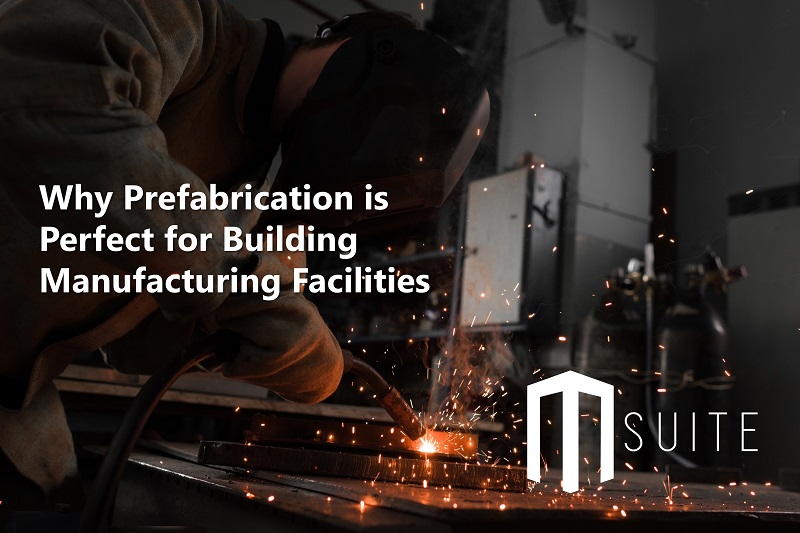Construction and manufacturing sectors historically have worked very differently. In manufacturing, optimizing production processes are the number one goal – delivering the highest efficiency and quality. By contrast, traditional construction companies tend to work from project to project selecting the best collaborators, materials, and methods (Design-Build, Design-Bid-Build, etc.) to meet specific needs.
Now, prefabrication can bring the two worlds closer together. By fabricating components off-site, contractors can expect more consistent builds and higher quality outputs. Projects with significant mechanical, electrical, plumbing, industrial, and hardened structural requirements, like manufacturing facilities, exceptionally benefit.
Manufacturers can use productization: when subcontractors create defined prefabricated elements (the “products”) that can be procured for construction projects and incorporated straight into designs.
Here is why prefabrication and productization are perfect techniques for building manufacturing facilities and how digital construction tools can help you get there.
Greater certainty on every construction build
Consistency and certainty are critical in manufacturing, especially running multiple sites. Manufacturers want to produce consistent products, particularly heavily regulated goods – which means consistent facilities. So rather than starting from scratch on every project, it’s better to have uniform facilities that are constructed – then operated – in the same way every time.
The challenge is that traditional construction methods involve multiple skilled trade workers working on-site, increasing complexity and the risk of delays or changes. By contrast, prefabrication extracts whole elements from the jobsite, giving owners greater certainty over cost, schedule, and output.
What’s more, with digital collaboration platforms, owners can access real-time updates on the fabrication of these elements so that everyone has a clear view of the project schedule, even away from the site. This keeps the build on time, enabling the facility to get up and running as quickly as possible.
Accessing the power of productization
Prefabrication brings considerable advantages, but manufacturers are well-positioned to take it further to productization. This means partnering with construction specialists who create a scalable, defined, managed, and optimized product – from ceilings to modular bathroom pods.
Digital construction networks like Building Connected can help owners and designers find the right prefabrication partners for this process and check quality for the work. These subcontractors can then provide highly sophisticated, data-rich designs for each element they deliver using BIM.
This means manufacturers can find the best fit for their facilities – and provide critical feedback for optimizing these ‘products’ in the future so the design of their assets can continue to improve.
Productization can deliver value from the first build and throughout an asset’s lifecycle. Importantly, unlike some owners, manufacturers already embrace productization by emphasizing factors like capability and scope for collaborating with fabricators.
Decoupling legacy or manual technology
Manufacturing technology, such as assembly line robots, will evolve and need to be replaced. However, this can be costly and result in significant downtime in facilities.
With productization, these components can be decoupled from their enclosures and much more easily replaced. This gives manufacturers greater flexibility – and minimizes downtime for upgrades.
Access to rich BIM records on the facility can help speed up the renovation process, providing installation teams with the information on assets required to complete the operational process – and get manufacturing back up and running at speed.
Facilities scaling to match demand
When you’re commissioning new manufacturing facilities, you often need to anticipate customer demand in the future to ensure that your investment is worthwhile. But especially in today’s volatile environment, things can change rapidly.
Productization means manufacturers can more easily scale their facilities as demand grows – or not if the capacity isn’t needed. In addition, having these more flexible facilities means that manufacturers don’t have to risk capital anticipating future demand and can be more reactive to change.
Digital construction platforms like Autodesk Build can enable owners, contractors, and fabricators to collaborate seamlessly on these projects for productive and efficient builds. This means manufacturers can scale up and expand quickly to meet needed demand.
Greater sustainability
There’s pressure on manufacturers to become more sustainable, with our current leadership seeking a 50-52 percent reduction from 2005 levels in net greenhouse gas pollution in 2030. But particularly on projects with large MEP requirements, using traditional construction methods results in significant waste during construction.
Fabricating components off-site is more energy-efficient and reduces waste created during construction – and so the environmental impact of the build. Subcontractors can also share rich BIM data on each element’s embodied carbon and energy efficiency through digital collaboration platforms, enabling designers to choose the most sustainable option for the facility.
This will help manufacturers sustainably construct and operate their facilities and meet their green targets.
Further advances and enabling digital twins
Productization opens several other advances for manufacturing facilities. For example, prefabricated components can come with rich BIM data on their makeup and performance – which can then be incorporated into digital twins. Over time, we’ll be able to move from this metadata to operational data that can inform day-to-day operating decisions and future design improvements for the components. But all of this starts with creating rich digital records today using BIM.
Using standardized components will also make applying advanced building techniques like robotics, laser scanners, etc., easier, so manufacturers can benefit from even faster, more consistent construction.
Transforming construction
Prefabrication and productization are already starting to transform construction. Owners of manufacturing facilities might consider taking advantage of this methodology and benefit from greater certainty, quality, and flexibility in every build. This will also help drive change in the broader industry – and benefit everyone.







